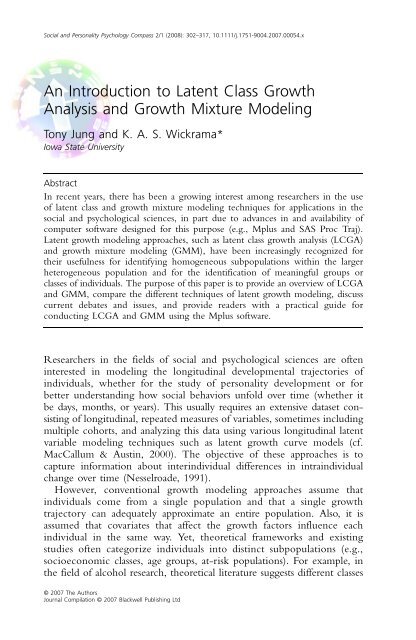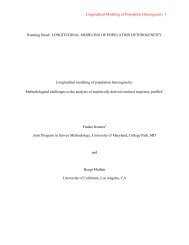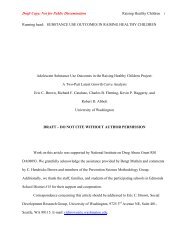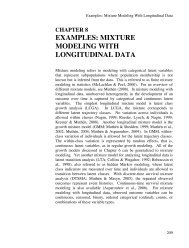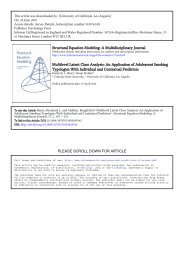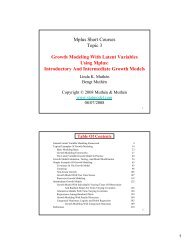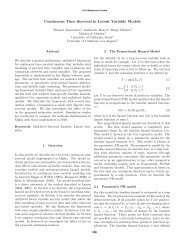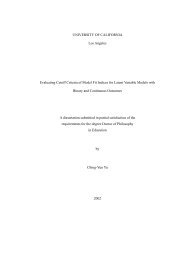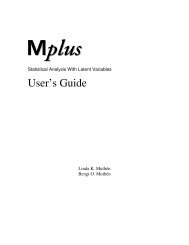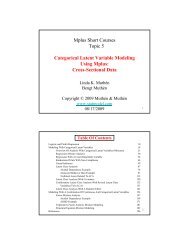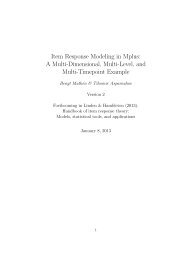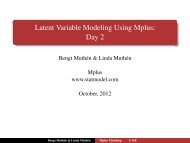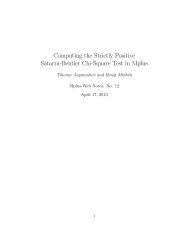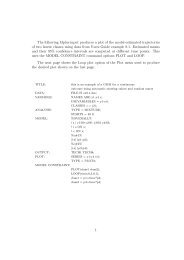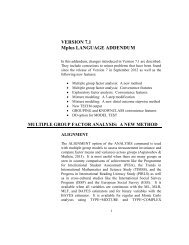An Introduction to Latent Class Growth Analysis and Growth ... - Mplus
An Introduction to Latent Class Growth Analysis and Growth ... - Mplus
An Introduction to Latent Class Growth Analysis and Growth ... - Mplus
Create successful ePaper yourself
Turn your PDF publications into a flip-book with our unique Google optimized e-Paper software.
Social <strong>and</strong> Personality Psychology Compass 2/1 (2008): 302–317, 10.1111/j.1751-9004.2007.00054.x<br />
<strong>An</strong> <strong>Introduction</strong> <strong>to</strong> <strong>Latent</strong> <strong>Class</strong> <strong>Growth</strong><br />
<strong>An</strong>alysis <strong>and</strong> <strong>Growth</strong> Mixture Modeling<br />
Tony Jung <strong>and</strong> K. A. S. Wickrama*<br />
Iowa State University<br />
Abstract<br />
In recent years, there has been a growing interest among researchers in the use<br />
of latent class <strong>and</strong> growth mixture modeling techniques for applications in the<br />
social <strong>and</strong> psychological sciences, in part due <strong>to</strong> advances in <strong>and</strong> availability of<br />
computer software designed for this purpose (e.g., <strong>Mplus</strong> <strong>and</strong> SAS Proc Traj).<br />
<strong>Latent</strong> growth modeling approaches, such as latent class growth analysis (LCGA)<br />
<strong>and</strong> growth mixture modeling (GMM), have been increasingly recognized for<br />
their usefulness for identifying homogeneous subpopulations within the larger<br />
heterogeneous population <strong>and</strong> for the identification of meaningful groups or<br />
classes of individuals. The purpose of this paper is <strong>to</strong> provide an overview of LCGA<br />
<strong>and</strong> GMM, compare the different techniques of latent growth modeling, discuss<br />
current debates <strong>and</strong> issues, <strong>and</strong> provide readers with a practical guide for<br />
conducting LCGA <strong>and</strong> GMM using the <strong>Mplus</strong> software.<br />
Researchers in the fields of social <strong>and</strong> psychological sciences are often<br />
interested in modeling the longitudinal developmental trajec<strong>to</strong>ries of<br />
individuals, whether for the study of personality development or for<br />
better underst<strong>and</strong>ing how social behaviors unfold over time (whether it<br />
be days, months, or years). This usually requires an extensive dataset consisting<br />
of longitudinal, repeated measures of variables, sometimes including<br />
multiple cohorts, <strong>and</strong> analyzing this data using various longitudinal latent<br />
variable modeling techniques such as latent growth curve models (cf.<br />
MacCallum & Austin, 2000). The objective of these approaches is <strong>to</strong><br />
capture information about interindividual differences in intraindividual<br />
change over time (Nesselroade, 1991).<br />
However, conventional growth modeling approaches assume that<br />
individuals come from a single population <strong>and</strong> that a single growth<br />
trajec<strong>to</strong>ry can adequately approximate an entire population. Also, it is<br />
assumed that covariates that affect the growth fac<strong>to</strong>rs influence each<br />
individual in the same way. Yet, theoretical frameworks <strong>and</strong> existing<br />
studies often categorize individuals in<strong>to</strong> distinct subpopulations (e.g.,<br />
socioeconomic classes, age groups, at-risk populations). For example, in<br />
the field of alcohol research, theoretical literature suggests different classes<br />
© 2007 The Authors<br />
Journal Compilation © 2007 Blackwell Publishing Ltd
<strong>Latent</strong> Trajec<strong>to</strong>ry <strong>Class</strong>es 303<br />
of alcohol use initiation patterns, e.g., ‘early’ versus ‘late’ onsetters (Hill,<br />
White, Chung, Hawkins, & Catalano, 2000). Using growth mixture modeling<br />
(GMM) with five different indices of alcohol use (alcohol use disorder,<br />
alcohol dependence, alcohol consequences, past year alcohol quantity <strong>and</strong><br />
frequency, <strong>and</strong> heavy drinking), Jackson <strong>and</strong> Sher (2005) identified four<br />
distinct classes for each measure. The results of these studies confirm<br />
theoretical contentions that heterogeneity of growth trajec<strong>to</strong>ries exist<br />
within the larger population. In addition, these findings suggest that<br />
describing an entire population using a single growth trajec<strong>to</strong>ry estimate<br />
is oversimplifying the complex growth patterns that describe continuity<br />
<strong>and</strong> change among members of different groups. Instead, a latent class or<br />
growth mixture modeling approach seems <strong>to</strong> be the most appropriate<br />
method for fully capturing information about interindividual differences<br />
in intraindividual change taking in<strong>to</strong> account unobserved heterogeneity<br />
(different groups) within a larger population.<br />
Person-Centered <strong>and</strong> Variable-Centered <strong>An</strong>alyses<br />
A useful framework for beginning <strong>to</strong> underst<strong>and</strong> latent class analysis <strong>and</strong><br />
growth mixture modeling is the distinction between person-centered <strong>and</strong><br />
variable-centered approaches (cf. Muthén & Muthén, 2000). Variablecentered<br />
approaches such as regression, fac<strong>to</strong>r analysis, <strong>and</strong> structural<br />
equation modeling focus on describing the relationships among variables.<br />
The goal is <strong>to</strong> identify significant predic<strong>to</strong>rs of outcomes, <strong>and</strong> describe<br />
how dependent <strong>and</strong> independent variables are related. Person-centered<br />
approaches, on the other h<strong>and</strong>, include methods such as cluster analysis,<br />
latent class analysis, <strong>and</strong> finite mixture modeling. The focus is on the<br />
relationships among individuals, <strong>and</strong> the goal is <strong>to</strong> classify individuals in<strong>to</strong><br />
distinct groups or categories based on individual response patterns so that<br />
individuals within a group are more similar than individuals between<br />
groups.<br />
<strong>Growth</strong> Mixture Modeling<br />
Given a typical sample of individual growth trajec<strong>to</strong>ries (Figure 1, left),<br />
conventional growth modeling approaches give a single average growth<br />
estimate (bold line), a single estimation of variance of the growth parameters,<br />
<strong>and</strong> assumes a uniform influence of covariates on the variance <strong>and</strong> growth<br />
parameters. However, there may exist a subset of individuals (Figure 1,<br />
right) whose growth trajec<strong>to</strong>ries are significantly different from the overall<br />
estimate. In this example, the figure on the left-h<strong>and</strong> side represents a<br />
sample of individual adolescent mental health growth trajec<strong>to</strong>ries (SCL-90-R<br />
depression, anxiety, <strong>and</strong> somatic symp<strong>to</strong>ms measures), with an average<br />
positive intercept <strong>and</strong> slope. The figure on the right-h<strong>and</strong> side is a<br />
subset of the entire sample, representing adolescent mental health growth<br />
© 2007 The Authors Social <strong>and</strong> Personality Psychology Compass 2/1 (2008): 302–317, 10.1111/j.1751-9004.2007.00054.x<br />
Journal Compilation © 2007 Blackwell Publishing Ltd
304 <strong>Latent</strong> Trajec<strong>to</strong>ry <strong>Class</strong>es<br />
Figure 1 Individual trajec<strong>to</strong>ries for adolescent mental health (left) <strong>and</strong> the recovery class<br />
(right).<br />
trajec<strong>to</strong>ries that are decreasing in poor mental health symp<strong>to</strong>mology, that<br />
is, improving mental health. Individuals in this ‘recovery’ group have a<br />
higher intercept <strong>and</strong> a negative slope, characteristics of the growth<br />
parameters that are clearly different from that of the whole sample.<br />
The conventional growth model can be described as a multilevel, r<strong>and</strong>omeffects<br />
model (Raudenbush & Bryk, 2002). According <strong>to</strong> this framework,<br />
intercept <strong>and</strong> slope vary across individuals <strong>and</strong> this heterogeneity is captured<br />
by r<strong>and</strong>om effects (i.e., continuous latent variables). However, as mentioned<br />
previously, this approach assumes that the growth trajec<strong>to</strong>ries of all<br />
individuals can be adequately described using a single estimate of growth<br />
parameters (both the mathematical form <strong>and</strong> the magnitude). Underlying<br />
this framework is the assumption that all individuals are drawn from a<br />
single population with common parameters. GMM, on the other h<strong>and</strong>,<br />
relaxes this assumption <strong>and</strong> allows for differences in growth parameters<br />
across unobserved subpopulations. This is accomplished using latent trajec<strong>to</strong>ry<br />
classes (i.e., categorical latent variables), which allow for different<br />
groups of individual growth trajec<strong>to</strong>ries <strong>to</strong> vary around different means<br />
(with the same or different forms). The results are separate growth models<br />
for each latent class, each with its unique estimates of variances <strong>and</strong><br />
covariate influences. This modeling flexibility is the basis of the GMM<br />
framework (cf. Muthén & Asparaouhov, 2006).<br />
<strong>Latent</strong> class growth analysis (LCGA) is a special type of GMM, whereby<br />
the variance <strong>and</strong> covariance estimates for the growth fac<strong>to</strong>rs within each<br />
class are assumed <strong>to</strong> be fixed <strong>to</strong> zero. By this assumption, all individual<br />
growth trajec<strong>to</strong>ries within a class are homogeneous. This framework of<br />
growth modeling has been extensively developed by Nagin <strong>and</strong> colleagues<br />
(cf. Nagin & L<strong>and</strong>, 1993) <strong>and</strong> is embodied in the SAS procedure Proc<br />
Traj (Jones, Nagin, & Roeder, 2001). The benefit of this approach is the<br />
identification of distinct classes prior <strong>to</strong> conducting GMM. It serves as a<br />
starting point for conducting GMM. In terms of computation, it is easy<br />
<strong>to</strong> specify in <strong>Mplus</strong> <strong>and</strong> the zero constraints on the variance estimates<br />
allow for faster model convergence (cf. Kreuter & Muthén, 2007).<br />
© 2007 The Authors Social <strong>and</strong> Personality Psychology Compass 2/1 (2008): 302–317, 10.1111/j.1751-9004.2007.00054.x<br />
Journal Compilation © 2007 Blackwell Publishing Ltd
Current Issues <strong>and</strong> Debate<br />
<strong>Latent</strong> Trajec<strong>to</strong>ry <strong>Class</strong>es 305<br />
Much of the current issues <strong>and</strong> debate surround three main areas: (i) the<br />
determination of latent trajec<strong>to</strong>ry classes; (ii) which model fit index <strong>to</strong><br />
use; <strong>and</strong> (iii) the problem of convergence. The first issue is concerned<br />
with the question whether latent classes really exist <strong>and</strong> if so, how many?<br />
For example, Bauer <strong>and</strong> Curran (2003a, b) cautioned that the existence of<br />
multiple classes may simply be due <strong>to</strong> skewed or nonnormally distributed<br />
data.<br />
Assuming there are multiple classes, how does one determine how<br />
many there are? Currently, methods for determining the number of<br />
components in a growth mixture model consists of finding the model<br />
with the smallest Bayesian information criteria (BIC) value <strong>and</strong> a significant<br />
Lo, Mendell, <strong>and</strong> Rubin (2001) likelihood ratio test (LMR-LRT)<br />
statistic. More recently, however, further simulations have demonstrated<br />
that while the BIC performed the best among the information criteriabased<br />
indices, the bootstrap likelihood ratio test (BLRT) proved <strong>to</strong> a<br />
better indica<strong>to</strong>r of classes across all of the models considered. All of these<br />
fit indices are available in <strong>Mplus</strong> (see Nylund, Asparouhov, & Muthén,<br />
2007, for a discussion on fit indices). <strong>An</strong>alogous <strong>to</strong> determining the<br />
number of fac<strong>to</strong>rs using explora<strong>to</strong>ry fac<strong>to</strong>r analysis, the number of classes<br />
should ultimately be determined by a combination of fac<strong>to</strong>rs in addition<br />
<strong>to</strong> fit indices, including one’s research question, parsimony, theoretical<br />
justification, <strong>and</strong> interpretability (cf. Bauer & Curran, 2003b; Muthén,<br />
2003; Rindskopf, 2003).<br />
A third issue that is often raised is the problem of nonconvergence <strong>and</strong><br />
local solutions (cf. Hipp & Bauer, 2006). Trying <strong>to</strong> mathematically model<br />
a sample distribution that consists of a mixture of many different kinds<br />
of subdistributions (i.e., a finite mixture model) is extremely difficult.<br />
Such attempts are no<strong>to</strong>rious for convergence issues due <strong>to</strong> likelihood<br />
estimation problems (e.g., local minima <strong>and</strong> maxima <strong>and</strong> singularities).<br />
Like other methods such as cluster analysis, latent class analysis, <strong>and</strong> finite<br />
fixture modeling, growth mixture models are also susceptible <strong>to</strong> local<br />
solutions. The problem of local solutions is where during curve estimation<br />
a largest value (maximum) or smallest value (minimum) that a function<br />
takes is identified for only a given area on that curve, but that is not<br />
necessarily the largest or smallest value for the entire curve (i.e., the global<br />
minimum or maximum). The problem with local solutions in latent class<br />
analysis has long been known (Goodman, 1974). In mixture modeling,<br />
parameters are estimated by the method of maximum likelihood <strong>and</strong> are<br />
iterative in nature (e.g., EM algorithm). Ideally, the iteration will result in<br />
successful convergence on the global maximum solution, that is, the<br />
parameter estimates associated with the largest loglikelihood. However,<br />
the algorithm cannot distinguish between a global maximum <strong>and</strong> a local<br />
maximum. As long as it reaches some maximum, the algorithm will<br />
© 2007 The Authors Social <strong>and</strong> Personality Psychology Compass 2/1 (2008): 302–317, 10.1111/j.1751-9004.2007.00054.x<br />
Journal Compilation © 2007 Blackwell Publishing Ltd
306 <strong>Latent</strong> Trajec<strong>to</strong>ry <strong>Class</strong>es<br />
Figure 2 Representation of a growth mixture model with covariates.<br />
terminate. Fortunately, the <strong>Mplus</strong> software incorporates the use of r<strong>and</strong>om<br />
starting values, with sufficient user flexibility, <strong>to</strong> avoid local solutions in<br />
GMM.<br />
GMM <strong>and</strong> LCGA in <strong>Mplus</strong><br />
This section outlines the basic steps for specifying a simple LCGA <strong>and</strong><br />
GMM model in <strong>Mplus</strong> Version 4.1, briefly explains the different usermodifiable<br />
options, <strong>and</strong> highlights specific parts of the output that the<br />
beginning user needs <strong>to</strong> be aware of. Readers are recommended <strong>to</strong> refer<br />
<strong>to</strong> Chapter 8 in the <strong>Mplus</strong> User’s Manual available at www.statmodel.com<br />
for a complete treatment of longitudinal mixture modeling. Examples<br />
of input <strong>and</strong> output for more complex analyses, with more detailed<br />
instructions are available at www.statmodel.com/examples/penn.shtml.<br />
The general latent variable growth mixture model can be represented as<br />
follows:<br />
The growth mixture model in Figure 2 consists of the following<br />
components: (i) a univariate latent growth curve of observed variable T<br />
with an intercept (I) <strong>and</strong> slope (S), (ii) a categorical variable for class (C),<br />
<strong>and</strong> (iii) covariates or predic<strong>to</strong>r variables (X). A distal continuous outcome<br />
variable (Y) or a dicho<strong>to</strong>mous outcome variable (U) can be also added <strong>to</strong><br />
the model by regressing Y on<strong>to</strong> C, but is not shown here. The simple<br />
univariate latent growth curve with latent growth fac<strong>to</strong>rs, intercept (I)<br />
<strong>and</strong> slope (S), are formed by the observed variables T1, T2, <strong>and</strong> T3 that<br />
represent repeated measures across three time points. A fourth repeated<br />
measure (T4) could also be added <strong>to</strong> the model <strong>to</strong> estimate a quadratic<br />
growth fac<strong>to</strong>r (Q), but for sake of simplicity only the slope fac<strong>to</strong>r is<br />
© 2007 The Authors Social <strong>and</strong> Personality Psychology Compass 2/1 (2008): 302–317, 10.1111/j.1751-9004.2007.00054.x<br />
Journal Compilation © 2007 Blackwell Publishing Ltd
<strong>Latent</strong> Trajec<strong>to</strong>ry <strong>Class</strong>es 307<br />
considered here. As an aside, estimating additional growth fac<strong>to</strong>rs, for<br />
example, a quadratic term, will add computational burden, so it is not<br />
unusual <strong>to</strong> see the variance of the quadratic term <strong>and</strong> other growth fac<strong>to</strong>rs<br />
in select classes fixed <strong>to</strong> zero <strong>to</strong> aid in convergence during GMM.<br />
The categorical latent class variable (C) is related <strong>to</strong> the covariates (X)<br />
by way of multinomial logistical regression. The <strong>Mplus</strong> multinomial<br />
regression assigns each individual fractionally <strong>to</strong> all classes using the<br />
posterior probabilities, obtained through the EM iterations. The first set<br />
of fractional assignments is based on the starting values, <strong>and</strong> they are then<br />
iteratively improved on until convergence. In the case of a dicho<strong>to</strong>mous<br />
covariate (e.g., 0 = females, 1 = males), the coefficient is the increase in<br />
the log-odds of being in the disengaged versus the normative class for a<br />
one-unit increase in X, for example, when comparing males <strong>to</strong> females<br />
in this example. Hence, a coefficient of 1.0 implies that the odds of being<br />
in the disengaged class versus the normative class is exp(1) = 2.72 times<br />
higher for males than females. The same odds ratio interpretation applies<br />
<strong>to</strong> each class when including a dicho<strong>to</strong>mous distal outcome variable (U).<br />
See Muthén (2004, 349) for further detail on multinomial logistic regression<br />
in <strong>Mplus</strong>.<br />
Step 1: Specify a single-class latent growth curve model<br />
The initial step prior <strong>to</strong> specifying latent classes is <strong>to</strong> specify a single-class<br />
growth model. For example, a univariate growth curve model without<br />
covariates may be an initial starting point for beginning users. In <strong>Mplus</strong>,<br />
a univariate latent growth curve can be specified as follows:<br />
Title: UNIVARIATE GROWTH CURVE<br />
Data: file is ‘C:\My Folder\filename.dat’;<br />
Variable: names are id sex t1 t2 t3 x;<br />
usevar = t1–t3;<br />
missing = all (999);<br />
<strong>An</strong>alysis: type = missing H1;<br />
Model: i s | t1@0 t2@1 t3@2;<br />
Output: sampstat st<strong>and</strong>ardized tech1;<br />
In this dataset, there are six variables <strong>and</strong> missing values are coded as ‘999’.<br />
For the present analysis, only the three observed variables in the dataset<br />
are needed (USEVAR = T1 – T3). The TYPE = MISSING syntax invokes<br />
the full-information maximum likelihood algorithm for h<strong>and</strong>ling missing<br />
data. The MODEL syntax specifies the appropriate fac<strong>to</strong>r loadings corresponding<br />
<strong>to</strong> the equidistant time intervals, 0, 1, <strong>and</strong> 2, for the intercept<br />
(I) <strong>and</strong> slope (S). The zero time score for the slope growth fac<strong>to</strong>r at time 1<br />
defines the intercept growth fac<strong>to</strong>r as an initial status fac<strong>to</strong>r. The coefficients of<br />
© 2007 The Authors Social <strong>and</strong> Personality Psychology Compass 2/1 (2008): 302–317, 10.1111/j.1751-9004.2007.00054.x<br />
Journal Compilation © 2007 Blackwell Publishing Ltd
308 <strong>Latent</strong> Trajec<strong>to</strong>ry <strong>Class</strong>es<br />
the intercept growth fac<strong>to</strong>r are fixed at one as the default. The user has the<br />
option of freely estimating a fac<strong>to</strong>r loading by simply deleting it (e.g., delete<br />
‘@1’ <strong>to</strong> freely estimate the second time point, T2). Note that the | syntax<br />
is a new option introduced with <strong>Mplus</strong> Version 3, which replaces the BY<br />
syntax option. The BY option is a general approach <strong>to</strong> defining latent variables<br />
in <strong>Mplus</strong>. The new | syntax is used <strong>to</strong> name <strong>and</strong> define r<strong>and</strong>om effect<br />
variables <strong>and</strong> is used for specifying growth models. It calls for a different<br />
start value algorithm whereby parameters are perturbed differently as a<br />
function of their st<strong>and</strong>ard deviations. This syntax specifies the following<br />
latent univariate growth curve model:<br />
Figure 3 A latent variable representation of a univariate growth curve model.<br />
Step 2: Specify an unconditional latent class model without covariates (X)<br />
or distal outcomes (Y or U)<br />
However, if the covariates have significant direct effects on the growth<br />
fac<strong>to</strong>rs (I <strong>and</strong> S) <strong>and</strong> on class (C), then it is important <strong>to</strong> keep in mind<br />
that the unconditional model will lead <strong>to</strong> dis<strong>to</strong>rted results since the<br />
observed variables (T1–T3) will be incorrectly related <strong>to</strong> class (C). This<br />
is analogous <strong>to</strong> a misspecified regression model, where the slope estimate<br />
will be dis<strong>to</strong>rted when important predic<strong>to</strong>rs are left out of the equation.<br />
Therefore, it is important <strong>to</strong> follow-up the unconditional model with<br />
the appropriate conditional model <strong>and</strong> <strong>to</strong> compare the results (Muthén,<br />
2004).<br />
At this step, specifying a LCGA model with no within-class variance is<br />
also recommended as an initial explora<strong>to</strong>ry option. As discussed previously,<br />
LCGA is a useful initial modeling step prior <strong>to</strong> specifying a GMM model.<br />
The main difference is that LCGA assumes no within class variance on the<br />
growth fac<strong>to</strong>rs, whereas GMM freely estimates the within class variances.<br />
The benefits of fixing the within-class variances <strong>to</strong> zero are the clearer<br />
identification of classes <strong>and</strong> also the less computational burden – fac<strong>to</strong>rs<br />
that are important at this stage in model building. It is also recommended<br />
© 2007 The Authors Social <strong>and</strong> Personality Psychology Compass 2/1 (2008): 302–317, 10.1111/j.1751-9004.2007.00054.x<br />
Journal Compilation © 2007 Blackwell Publishing Ltd
<strong>Latent</strong> Trajec<strong>to</strong>ry <strong>Class</strong>es 309<br />
that LCGA be used with the conditioned model before proceeding <strong>to</strong><br />
GMM. In <strong>Mplus</strong>, an unconditional LCGA model can be specified as follows:<br />
Title: LATENT CLASS GROWTH ANALYSIS<br />
Data: file is ‘C:\My Folder\filename.dat’;<br />
Variable: names are id sex t1 t2 t3 x;<br />
usevar = t1–t3;<br />
missing = all (999);<br />
CLASSES = c(3);<br />
<strong>An</strong>alysis: type = MIXTURE missing;<br />
STARTS = 10 2;<br />
STITERATIONS = 10;<br />
Model: % OVERALL%<br />
i s | t1@0 t2@1 t3@2;<br />
i-s@0;<br />
Output: sampstat st<strong>and</strong>ardized tech1<br />
TECH8 TECH11 TECH14;<br />
PLOT: SERIES = t1–t3 (s);<br />
TYPE = PLOT3;<br />
The bold portions of the syntax are the parts that add the LCGA<br />
model (C) <strong>to</strong> the existing univariate growth curve model. The<br />
TYPE = MIXTURE syntax invokes the mixture model algorithm. Here,<br />
a three-class model is being initially examined with the syntax<br />
CLASSES = c(3). After successful convergence, note the model fit using<br />
the BIC value <strong>and</strong> then proceed <strong>to</strong> check models with more classes by<br />
replacing the ‘3’ with the appropriate number in the syntax. The best<br />
fitting model will have the smallest BIC value. However, BIC is only one<br />
of the options for determining model fit. In addition <strong>to</strong> the BIC, the<br />
LMR-LRT <strong>and</strong> the BLRT tests discussed earlier can also be examined by<br />
including TECH11 or TECH14 syntax, respectively, in the OUTPUT<br />
line. In this example, TECH8 shows the iteration process so that the user<br />
can be aware of iteration progress.<br />
The STARTS <strong>and</strong> STITERATIONS lines are not required for conducting<br />
LCGA since <strong>Mplus</strong> au<strong>to</strong>matically sets these parameters at default<br />
values. However, adjusting these values may aid in obtaining successful<br />
convergence. The STARTS syntax specifies the number of r<strong>and</strong>om sets of<br />
starting values (default = 10) followed by the number of final optimizations<br />
(default = 2), which optimizes the two best sets identified by the<br />
highest loglikelihood values after the initial round of optimizations given<br />
by the syntax STITERATIONS (default = 10). This feature, which can<br />
be user defined, is rare in other software programs <strong>and</strong> is one of the main<br />
approaches <strong>to</strong> addressing problems relating <strong>to</strong> nonconvergence <strong>and</strong> local<br />
maxima. For a more thorough investigation of multiple solutions, it is<br />
recommended that the user change the default values for the number of<br />
r<strong>and</strong>om sets <strong>and</strong> start iterations <strong>to</strong>:<br />
© 2007 The Authors Social <strong>and</strong> Personality Psychology Compass 2/1 (2008): 302–317, 10.1111/j.1751-9004.2007.00054.x<br />
Journal Compilation © 2007 Blackwell Publishing Ltd
310 <strong>Latent</strong> Trajec<strong>to</strong>ry <strong>Class</strong>es<br />
OR:<br />
STARTS = 100 10;<br />
STITERATIONS = 10;<br />
STARTS = 500 20;<br />
STITERATIONS = 20;<br />
Certainly, the user may change the start values <strong>to</strong> even higher numbers<br />
<strong>to</strong> ensure successful convergence. However, changing <strong>to</strong> higher values will<br />
increase computational burden <strong>and</strong> increase computation time.<br />
The syntax %OVERALL% specifies the same model <strong>and</strong> free estimates<br />
across all classes. The intercepts <strong>and</strong> residual variances of the growth<br />
fac<strong>to</strong>rs are estimated as the default, <strong>and</strong> the growth fac<strong>to</strong>r residual covariance<br />
is estimated as the default because the growth fac<strong>to</strong>rs do not influence any<br />
variable in the model except their own indica<strong>to</strong>rs. The intercepts of the<br />
growth fac<strong>to</strong>rs are not held equal across classes as the default. However,<br />
the residual variances <strong>and</strong> residual covariance of the growth fac<strong>to</strong>rs are<br />
held equal across classes as the default. In this example, the syntax i-s@0<br />
fixes all within-class variances <strong>to</strong> zero, consistent with the LCGA<br />
approach. Removing this line will set the variances of I <strong>and</strong> S as equal<br />
across all classes <strong>and</strong> estimate the variances of the growth parameters. If<br />
separate estimates of the within-class variances are desired for each class, it<br />
is necessary <strong>to</strong> add the following changes <strong>to</strong> the MODEL line in the syntax:<br />
Model: %OVERALL%<br />
i s | t1@0 t2@1 t3@2;<br />
%c#1%<br />
i s ;<br />
%c#2%<br />
i s;<br />
%c#3%<br />
i s;<br />
These added lines in bold tell <strong>Mplus</strong> <strong>to</strong> estimate the unique variances<br />
of intercept <strong>and</strong> slope for each class. This would be equivalent <strong>to</strong> a GMM<br />
model where the within-class variances are allowed <strong>to</strong> be freely estimated<br />
instead of fixed <strong>to</strong> zero as in LCGA. However, because freely estimating<br />
the variances for all growth fac<strong>to</strong>rs in each class separately adds considerable<br />
computational burden, the user must choose growth parameter variances<br />
<strong>to</strong> freely estimate carefully. In general, increasing model complexity by<br />
adding classes, adding covariates, allowing across-class variation in covariance<br />
matrices can add <strong>to</strong> computation time, convergence problems, improper<br />
solutions, <strong>and</strong> overall model instability. Hence, it is not unusual <strong>to</strong> decide<br />
<strong>to</strong> only estimate intercept <strong>and</strong> not slope, or limit changes <strong>to</strong> a particular<br />
class rather than across all classes. These decisions should be made after<br />
successfully running a LCGA, then looking at the graphics using the<br />
© 2007 The Authors Social <strong>and</strong> Personality Psychology Compass 2/1 (2008): 302–317, 10.1111/j.1751-9004.2007.00054.x<br />
Journal Compilation © 2007 Blackwell Publishing Ltd
<strong>Latent</strong> Trajec<strong>to</strong>ry <strong>Class</strong>es 311<br />
estimated means <strong>and</strong> observed individual values plot given by the PLOT<br />
syntax [Alt-V or from pull-down menu: Graph → View Graphs] <strong>and</strong><br />
determine if any class needs its own class-specific variance. After examining<br />
the variances of the growth fac<strong>to</strong>rs for each class using the charts, it is<br />
necessary <strong>to</strong> reanalyze the model with the class-specific variance in line<br />
with the results of the initial LCGA findings.<br />
Step 3: Determine the number of classes<br />
It is important <strong>to</strong> reiterate the point made earlier that determining the<br />
number of classes depends on a combination of fac<strong>to</strong>rs in addition <strong>to</strong> fit<br />
indices, including one’s research question, parsimony, theoretical justification,<br />
<strong>and</strong> interpretability. Keeping this in mind, fit indices <strong>and</strong> tests of model<br />
fit should not be the final word in deciding on the number of classes.<br />
However, they are useful in the initial explora<strong>to</strong>ry stages of analyses. At<br />
this point, studies are ongoing <strong>and</strong> results are not conclusive regarding the<br />
best fit indices. Using simulations, Nylund et al. (2007) has determined<br />
that of all the fit indices <strong>and</strong> tests available in <strong>Mplus</strong>, the BLRT performed<br />
the best, followed by BIC <strong>and</strong> then ABIC. However, Nylund<br />
et al. (2007, 33–34) recommends: ‘due <strong>to</strong> the increased amount of computing<br />
time of the BLRT, it may be better <strong>to</strong> not request the BLRT<br />
in the initial steps of model exploration. Instead, one could use the BIC<br />
<strong>and</strong> the LMR P-values as guides <strong>to</strong> get close <strong>to</strong> possible solutions <strong>and</strong><br />
then once a few plausible models have been identified, reanalyze these<br />
model requesting the BLRT’. Following their recommendation, the model<br />
with a low BIC value <strong>and</strong> a significant LMR P-value comparing the k <strong>and</strong><br />
the k – 1 class model should initially guide our analysis. In other words,<br />
comparing the current model against the model with 1 less class than the<br />
current model of choice should give a LMR P-value less than 0.05.<br />
TECHNICAL 11 OUTPUT<br />
VUONG–LO–MENDELL–RUBIN LIKELIHOOD<br />
RATIO TEST FOR 2 (H0) VERSUS 3 CLASSES<br />
H0 Loglikelihood Value –256.426<br />
Two Times the Loglikelihood Difference 20.216<br />
Difference in the Number of Parameters 3<br />
Mean –10.943<br />
St<strong>and</strong>ard Deviation 29.068<br />
P-value 0.0476<br />
LO–MENDELL–RUBIN ADJUSTED LRT TEST<br />
Value 18.483<br />
P-value 0.0560<br />
TECHNICAL 14 OUTPUT<br />
R<strong>and</strong>om Starts Specification for the k–1 <strong>Class</strong> Model<br />
Number of initial stage r<strong>and</strong>om starts 0<br />
Number of final stage optimizations for the initial stage r<strong>and</strong>om starts 0<br />
R<strong>and</strong>om Starts Specification for the k <strong>Class</strong> Model<br />
© 2007 The Authors Social <strong>and</strong> Personality Psychology Compass 2/1 (2008): 302–317, 10.1111/j.1751-9004.2007.00054.x<br />
Journal Compilation © 2007 Blackwell Publishing Ltd
312 <strong>Latent</strong> Trajec<strong>to</strong>ry <strong>Class</strong>es<br />
Number of initial stage r<strong>and</strong>om starts 20<br />
Number of final stage optimizations 5<br />
Number of bootstrap draws requested Varies<br />
PARAMETRIC BOOTSTRAPPED LIKELIHOOD RATIO<br />
TEST FOR 2 (H0) VERSUS 3 CLASSES<br />
H0 Loglikelihood Value –256.426<br />
Two times the Loglikelihood Difference 20.216<br />
Difference in the Number of Parameters 3<br />
Approximate P-value 0.0000<br />
Successful Bootstrap Draws 20<br />
The results of the LMR-LRT <strong>and</strong> the BLRT can be seen in the output<br />
under the TECHNICAL 11 <strong>and</strong> TECHNICAL 14 sections, respectively.<br />
Here, the LMR-LRT <strong>and</strong> the BLRT both show a statistically significant<br />
difference between the two-class versus three-class models. This suggests that<br />
the three-class model gives significant improvement in model fit over the<br />
three-class model. The next step would be <strong>to</strong> compare the three-class model<br />
<strong>to</strong> the four-class model, <strong>and</strong> so on until the tests result in nonsignificance.<br />
Other considerations include successful convergence, high entropy<br />
value (near 1.0), no less than 1% of <strong>to</strong>tal count in a class, <strong>and</strong> high<br />
posterior probabilities (near 1.0). In the output window, one can find the<br />
following information under the TESTS OF MODEL FIT section:<br />
TESTS OF MODEL FIT<br />
Information Criteria<br />
Number of Free Parameters 14<br />
Akaike (AIC) 4752.782<br />
Bayesian (BIC) 4799.641<br />
Sample-Size Adjusted BIC (n* = (n + 2)/24) 4755.281<br />
Entropy 0.923<br />
FINAL CLASS COUNTS AND PROPORTIONS<br />
FOR THE LATENT CLASSES<br />
BASED ON THE ESTIMATED MODEL<br />
<strong>Latent</strong> <strong>Class</strong>es<br />
1 171.37719 0.81608<br />
2 27.44010 0.13067<br />
3 11.18271 0.05325<br />
Average <strong>Latent</strong> <strong>Class</strong> Probabilities For Most Likely <strong>Latent</strong> <strong>Class</strong> Membership (Row)<br />
by <strong>Latent</strong> <strong>Class</strong> (Column)<br />
1 2 3<br />
1 0.975 0.012 0.014<br />
2 0.055 0.941 0.003<br />
3 0.030 0.000 0.970<br />
There are no set cut-off criteria for deciding whether the entropy is<br />
reasonably high, however, in the output above, note that the entropy is<br />
near 1.0. Also the proportions for the latent classes are all above .01 or<br />
1%. Finally, the posterior probabilities (diagonal values) are all reasonably<br />
high, near 1.0. Together, these results suggest good model fit for the<br />
© 2007 The Authors Social <strong>and</strong> Personality Psychology Compass 2/1 (2008): 302–317, 10.1111/j.1751-9004.2007.00054.x<br />
Journal Compilation © 2007 Blackwell Publishing Ltd
<strong>Latent</strong> Trajec<strong>to</strong>ry <strong>Class</strong>es 313<br />
three-class model. Once the number of classes has been decided, one can<br />
look at the graphs <strong>and</strong> see the observed <strong>and</strong> estimated means <strong>and</strong> trajec<strong>to</strong>ries<br />
for each class. In <strong>Mplus</strong>, selecting Alt-V or from pull-down menu, Graph<br />
→ View Graphs → Estimated Means <strong>and</strong> Observed Individual Values <strong>to</strong> obtain<br />
the following graphs:<br />
Figure 4 Estimated means <strong>and</strong> observed individual growth trajec<strong>to</strong>ries for each latent class.<br />
Step 4: Address convergence issues<br />
As discussed previously, The STARTS syntax, which can be user defined,<br />
is one of the main approaches <strong>to</strong> addressing problems relating <strong>to</strong> nonconvergence<br />
<strong>and</strong> local maxima. The user can change the default values for<br />
the number of r<strong>and</strong>om sets <strong>and</strong> start iterations <strong>to</strong> higher values. However,<br />
even with successful convergence, it is necessary <strong>to</strong> check whether the<br />
solutions are local solutions. To do this, check the estimates in the output<br />
using the OPTSEED syntax on the seed values from the best loglikelihood<br />
values. If the estimates are replicated, then most likely you did not<br />
run in<strong>to</strong> local solutions. The best loglikelihood values are ordered from<br />
best <strong>to</strong> worst for you by <strong>Mplus</strong>. Alongside these loglikelihood values are<br />
the SEED values in the output:<br />
RANDOM STARTS RESULTS RANKED FROM THE<br />
BEST TO THE WORST LOGLIKELIHOOD VALUES<br />
Initial stage loglikelihood values, seeds,<br />
<strong>and</strong> initial stage start numbers:<br />
–2362.540 939021 8<br />
–2362.677 373505 88<br />
–2363.424 436460 89<br />
–2363.447 76974 16<br />
–2363.507 402224 91<br />
–2363.513 467339 66<br />
–2363.767 364676 27<br />
–2365.631 902278 21<br />
–2366.060 170954 86<br />
–2367.730 830392 35<br />
© 2007 The Authors Social <strong>and</strong> Personality Psychology Compass 2/1 (2008): 302–317, 10.1111/j.1751-9004.2007.00054.x<br />
Journal Compilation © 2007 Blackwell Publishing Ltd
314 <strong>Latent</strong> Trajec<strong>to</strong>ry <strong>Class</strong>es<br />
<strong>Mplus</strong> rank orders the best loglikelihood values <strong>to</strong> the worst. The middle<br />
column of numbers consists of the seed values. We need <strong>to</strong> check the<br />
model parameter estimates using OPTSEED on the seed values from the<br />
best loglikelihood values. If the estimates are replicated, then most likelihood<br />
you did not run in<strong>to</strong> local solutions. A successfully converged model<br />
will have the best loglikelihood values repeated at least twice. In this example,<br />
the first two values are the best loglikelihoods, with seed values 939021 <strong>and</strong><br />
373505 respectively. Next, we need <strong>to</strong> back <strong>to</strong> our original syntax <strong>and</strong> add a<br />
syntax line for OPTSEED = 939021; under the ANALYSIS line as follows:<br />
<strong>An</strong>alysis: type = MIXTURE missing;<br />
OPTSEED = 939021;<br />
After running this model, run another model using OPTSEED = 373505,<br />
then compare the results of both outputs. We should see our estimates<br />
replicated. If the estimates are replicated then we can trust that we did not<br />
find local solutions.<br />
Step 5: Specify a conditional latent class model with covariates (X)<br />
Next, Steps 2–4 as outlined above need <strong>to</strong> be repeated using a conditioned<br />
model. As mentioned previously, if the covariates have significant direct<br />
effects on the growth fac<strong>to</strong>rs (I <strong>and</strong> S) <strong>and</strong> on class (C), then the unconditional<br />
model will lead <strong>to</strong> dis<strong>to</strong>rted results since only the observed variables<br />
(T1–T3) will be incorrectly related <strong>to</strong> class (C). Therefore, it is important<br />
<strong>to</strong> follow-up the unconditional model with the appropriate conditional<br />
model <strong>and</strong> <strong>to</strong> compare the results. The conditioned model can be specified<br />
by adding the following bolded lines <strong>to</strong> the existing syntax:<br />
Title: LATENT CLASS GROWTH ANALYSIS<br />
Data: file is ‘C:\My Folder\filename.dat’;<br />
Variable: names are id sex t1 t2 t3 x;<br />
usevar = t1 – t3;<br />
missing = all (999);<br />
CLASSES = c(3);<br />
<strong>An</strong>alysis: type = MIXTURE missing;<br />
STARTS = 10 2;<br />
STITERATIONS = 10;<br />
Model: %OVERALL%<br />
i s|t1@0 t2@1 t3@2;<br />
i-s@0;<br />
i s ON x;<br />
c#1 ON x;<br />
c#2 ON x;<br />
Output: sampstat st<strong>and</strong>ardized tech1 TECH8 TECH11;<br />
PLOT: SERIES = t1 – t3 (s);<br />
TYPE = PLOT3;<br />
© 2007 The Authors Social <strong>and</strong> Personality Psychology Compass 2/1 (2008): 302–317, 10.1111/j.1751-9004.2007.00054.x<br />
Journal Compilation © 2007 Blackwell Publishing Ltd
<strong>Latent</strong> Trajec<strong>to</strong>ry <strong>Class</strong>es 315<br />
Up <strong>to</strong> this point, only the unconditional model was considered for pedagogical<br />
purposes. Furthermore, one disadvantage of conducting class<br />
analysis with covariates is that <strong>Mplus</strong> does not give graphs of the estimated<br />
<strong>and</strong> observed values for each class. Hence, it is wise <strong>to</strong> conduct initial<br />
explora<strong>to</strong>ry analyses with the unconditioned model <strong>to</strong> at least see how<br />
the individual growth trajec<strong>to</strong>ries <strong>and</strong> classes are distributed.<br />
The first ON statement regresses the intercept <strong>and</strong> slope growth fac<strong>to</strong>rs<br />
on<strong>to</strong> the time-invariant covariate (X). The second ON statement<br />
describes the multinomial logistic regression of the categorical latent<br />
variable (C) on the time-invariant covariate (X) when comparing class 1<br />
<strong>to</strong> classes 2 <strong>and</strong> 3.<br />
One final recommendation is <strong>to</strong> obtain the predicted class for each<br />
individual by saving the posterior probabilities <strong>and</strong> class assignments in<strong>to</strong><br />
an output text file. This option can be specified as follows:<br />
Title: LATENT CLASS GROWTH ANALYSIS<br />
Data: file is ‘C:\My Folder\filename.dat’;<br />
Variable: names are id sex t1 t2 t3 x;<br />
usevar = t1 – t3;<br />
IDVARIABLE = id;<br />
missing = all (999);<br />
CLASSES = c(3);<br />
SAVEDATA: FILE IS C:\MY FOLDER\CLASSoutput;<br />
save = cprobabilities;<br />
<strong>An</strong>alysis: type = MIXTURE missing;<br />
The IDVARIABLE syntax must correspond <strong>to</strong> the subject identifier<br />
variable in the dataset, here it is simply id. The SAVEDATA line specifies<br />
the location of the folder <strong>and</strong> filename ‘CLASSoutput’ by which the<br />
output is saved. The output text file can then be simply opened with MS<br />
WordPad <strong>and</strong> will look like the following:<br />
45.000 49.000 53.000 501.000 . . . . . . . . . . . . . . . 1.000<br />
50.000 43.000 68.000 502.000 . . . . . . . . . . . . . . . 1.000<br />
87.000 78.000 62.000 503.000 . . . . . . . . . . . . . . . 2.000<br />
38.000* 38.000 504.000 . . . . . . . . . . . . . . . 1.000<br />
54.000 48.000 48.000 505.000 . . . . . . . . . . . . . . . 1.000<br />
68.000 87.000 78.000 506.000 . . . . . . . . . . . . . . . 1.000<br />
95.000 50.000 45.000 507.000 . . . . . . . . . . . . . . . 2.000<br />
52.000* * 508.000 . . . . . . . . . . . . . . . 1.000<br />
44.000 43.000 98.000 509.000 . . . . . . . . . . . . . . . 3.000<br />
In this file, the first three columns correspond <strong>to</strong> the actual observed data<br />
for t1, t2, <strong>and</strong> t3, respectively. The asterisks correspond <strong>to</strong> missing values.<br />
The fourth column corresponds <strong>to</strong> the id variable. There will be many<br />
columns following the id column that contains the posterior probabilities<br />
© 2007 The Authors Social <strong>and</strong> Personality Psychology Compass 2/1 (2008): 302–317, 10.1111/j.1751-9004.2007.00054.x<br />
Journal Compilation © 2007 Blackwell Publishing Ltd
316 <strong>Latent</strong> Trajec<strong>to</strong>ry <strong>Class</strong>es<br />
<strong>and</strong> class probabilities (not shown here). The column of interest is the<br />
very last column at the far right that consists of the latent class number<br />
assigned by <strong>Mplus</strong>. Here, the values range from one <strong>to</strong> three since a threeclass<br />
model was estimated. One can easily export this class assignment<br />
information back in<strong>to</strong> the original dataset <strong>to</strong> be used for further analyses,<br />
such as conducting a test of mean differences across the classes on the<br />
covariates using ANOVA, or using class membership as a predic<strong>to</strong>r for<br />
distal outcome. Since <strong>Mplus</strong> does not give the graphs for each class from<br />
a conditioned latent class model, the user may opt <strong>to</strong> use these individual<br />
class assignments as the grouping variable for plotting each class separately<br />
using a different software package such as SAS, SPSS, or Excel. These class<br />
information can also be used for other analysis using these software packages.<br />
Summary<br />
Conventional growth model approaches such as the multilevel, r<strong>and</strong>omeffects<br />
model, assumes that the growth trajec<strong>to</strong>ries of all individuals can be<br />
adequately described using a single estimate of growth parameters. GMM<br />
<strong>and</strong> LCGA relax this assumption <strong>and</strong> allow for differences in growth parameters<br />
across unobserved subpopulations using latent trajec<strong>to</strong>ry classes. LCGA<br />
estimates a mean growth curve for each class, but no individual variation<br />
around the mean growth curve is allowed. GMM, on the other h<strong>and</strong>,<br />
combines the features of the r<strong>and</strong>om effects model <strong>and</strong> LCGA by estimating<br />
both mean growth curves for each class <strong>and</strong> individual variation around<br />
these growth curves by estimating growth fac<strong>to</strong>r variances for each class.<br />
Acknowledgment<br />
The dataset used in this paper comes from the Iowa Single Parent Project<br />
(Ron Simons, P.I.). The authors would like <strong>to</strong> thank Dr. Simons for<br />
letting them use his dataset for their paper.<br />
Short Biographies<br />
Tony Jung’s research interests center on longitudinal data analysis <strong>and</strong><br />
applying statistical methods <strong>to</strong> family research. He holds a PhD in Human<br />
Development <strong>and</strong> Family Studies from Iowa State University, <strong>and</strong> is<br />
currently pursuing an MS in Statistics.<br />
K. A. S. Wickrama’s research interests include social determinants of<br />
health <strong>and</strong> health inequality across the life course, racial/ethnical inequalities<br />
in mental <strong>and</strong> physical health of children <strong>and</strong> adults, international development<br />
<strong>and</strong> health, <strong>and</strong> application of advanced statistical methods <strong>to</strong><br />
social epidemiology. He holds a PhD in Human Development <strong>and</strong> Family<br />
Studies from Iowa State University.<br />
© 2007 The Authors Social <strong>and</strong> Personality Psychology Compass 2/1 (2008): 302–317, 10.1111/j.1751-9004.2007.00054.x<br />
Journal Compilation © 2007 Blackwell Publishing Ltd
Endnote<br />
<strong>Latent</strong> Trajec<strong>to</strong>ry <strong>Class</strong>es 317<br />
* Correspondence address: Institute for Social <strong>and</strong> Behavioral Research, 2625 North Loop<br />
Drive, Suite 500, Ames, Iowa 50010, USA. Email: s2kas@iastate.edu.<br />
References<br />
Bauer, D. J., & Curran, P. J. (2003a). Distributional assumptions of growth mixture models:<br />
Implications for overextraction of latent trajec<strong>to</strong>ry classes. Psychological Methods, 8, 338–363.<br />
Bauer, D. J., & Curran, P. J. (2003b). Overextraction of latent trajec<strong>to</strong>ry classes: Much ado<br />
about nothing? Reply <strong>to</strong> Rindskopf (2003), Muthén (2003), <strong>and</strong> Cudeck <strong>and</strong> Henly (2003).<br />
Psychological Methods, 8, 384–393.<br />
Goodman, L. A. (1974). Explora<strong>to</strong>ry latent structure analysis using both identifiable <strong>and</strong><br />
unidentifiable models. Biometrika, 61, 215–231.<br />
Hill, K. G., White, H. R., Chung, I., Hawkins, J. D., & Catalano, R. F. (2000). Early adult<br />
outcomes of adolescent binge drinking: Person- <strong>and</strong> variable-centered analyses of binge<br />
drinking trajec<strong>to</strong>ries. Alcoholism: Clinical & Experimental Research, 24, 892–901.<br />
Hipp, J. R., & Bauer, D. J. (2006). Local solutions in the estimation of growth mixture models.<br />
Psychological Methods, 11, 36–53.<br />
Jackson, K. M., & Sher, K. J. (2005). Similarities <strong>and</strong> differences of longitudinal phenotypes<br />
across alternate indices of alcohol involvement: A methodologic comparison of trajec<strong>to</strong>ry<br />
approaches. Psychology of Addictive Behaviors, 19, 339–351.<br />
Jones, B. L., Nagin, D. S., & Roeder, K. (2001). A SAS procedure based on mixture models<br />
for estimating developmental trajec<strong>to</strong>ries. Sociological Methods & Research, 29, 374–393.<br />
Kreuter, F., & Muthén, B. (2007). Longitudinal modeling of population heterogeneity:<br />
Methodological challenges <strong>to</strong> the analysis of empirically derived criminal trajec<strong>to</strong>ry profiles.<br />
In G. R. Hancock & K. M. Samuelsen (Eds.), Advances in <strong>Latent</strong> Variable Mixture Models.<br />
Charlotte, NC: Information Age Publishing.<br />
Lo, Y., Mendell, N. R., & Rubin, D. B. (2001). Testing the number of components in a normal<br />
mixture. Biometrika, 88, 767–778.<br />
MacCallum, R. C., & Austin, J. T. (2000). Applications of structural equation modeling in<br />
psychological research. <strong>An</strong>nual Review of Psychology, 51, 201–226.<br />
Muthén, B. (2003). Statistical <strong>and</strong> substantive checking in growth mixture modeling: Comment<br />
on Bauer <strong>and</strong> Curran (2003). Psychological Methods, 8, 369–377.<br />
Muthén, B. (2004). <strong>Latent</strong> variable analysis: <strong>Growth</strong> mixture modeling <strong>and</strong> related techniques<br />
for longitudinal data. In D. Kaplan (Ed.), H<strong>and</strong>book of Quantitative Methodology for the Social<br />
Sciences (pp. 345–368). Newbury Park, CA: Sage Publications.<br />
Muthén, B., & Asparouhov, T. (2006). <strong>Growth</strong> mixture analysis: Models with non-Gaussian<br />
r<strong>and</strong>om effects. Forthcoming In G. Fitzmaurice, M. Davidian, G. Verbeke, & G. Molenberghs<br />
(Eds.), Advances in Longitudinal Data <strong>An</strong>alysis. Boca Ra<strong>to</strong>n, FL: Chapman & Hall/CRC Press.<br />
Muthén, B., & Muthén, L. K. (2000). Integrating person-centered <strong>and</strong> variable-centered<br />
analyses: <strong>Growth</strong> mixture modeling with latent trajec<strong>to</strong>ry classes. Alcoholism: Clinical <strong>and</strong><br />
Experimental Research, 24, 882–891.<br />
Nagin, D. S., & L<strong>and</strong>, K. C. (1993). Age, criminal careers, <strong>and</strong> population heterogeneity: Specification<br />
<strong>and</strong> estimation of a nonparametric, mixed Poisson model. Criminology, 31, 327–362.<br />
Nesselroade, J. R. (1991). Interindividual differences in intraindividual change. In L. A. Collins<br />
& J. L. Horn (Eds.), Best Methods for the <strong>An</strong>alysis of Change (pp. 92–106). Washing<strong>to</strong>n, DC:<br />
American Psychological Association.<br />
Nylund, K. L., Asparouhov, T., & Muthén, B. (2007). Deciding on the number of classes in<br />
latent class analysis <strong>and</strong> growth mixture modeling: A Monte Carlo simulation study. Structural<br />
Equation Modeling: A Multidisciplinary Journal, 14, 535–569.<br />
Raudenbush, S. W., & Bryk, A. S. (2002). Hierarchical Linear Models: Applications <strong>and</strong> Data<br />
<strong>An</strong>alysis Methods (2nd ed.). Thous<strong>and</strong> Oaks, CA: Sage Publications.<br />
Rindskopf, D. (2003). Mixture or homogeneous? Comment on Bauer <strong>and</strong> Curran (2003).<br />
Psychological Methods, 8, 364–368.<br />
© 2007 The Authors Social <strong>and</strong> Personality Psychology Compass 2/1 (2008): 302–317, 10.1111/j.1751-9004.2007.00054.x<br />
Journal Compilation © 2007 Blackwell Publishing Ltd


